Key Takeaways
- Outperform competitors by focusing on gifts that create emotional value and feel like recognition, not just temporary price cuts or free random items.
- Implement tiered gifting by using a cart progress bar to visibly guide customers toward higher spending levels and greater rewards.
- Build long-term customer allegiance by ensuring gift offers are perfectly honest and clear, directly increasing brand trust and repeat purchases.
- The most noteworthy idea is to reward customers with a Post-Purchase “Earned” Gift, which motivates them to return for a second purchase.
We’ve all seen gift campaigns that flop: customers take the freebie, then disappear.
The truth is, gifting without purpose doesn’t create loyalty; it creates habits. But when it’s done with timing, relevance, and care, a free gift feels like recognition, not bait. This blog post will show you 8 ideas that prove thoughtful gifting pays back in loyalty and lifetime value.
What Makes a Free Gift Strategy Effective on Shopify?
There are three key points to make a free gift campaign effective on Shopify:
- Emotional value over monetary value
People react more strongly to emotion than to logic when shopping. Google’s Messy Middle research found that the Power of Free, even a small, unrelated gift, can shift real purchase decisions. In one test, an unknown brand gained 28% of shopper preference, and in extreme cases, up to 87%, when a free offer was added.
Why? Because “free” activates an instinctive reward response. Customers feel rewarded, not sold to, and that emotional satisfaction makes them remember your brand long after checkout.
- Context and relevance
A gift feels meaningful only when it fits the shopper’s journey. Behavioral science shows that people use mental shortcuts to simplify choices, which Google calls “category heuristics.” A relevant gift, such as a sample of a product they might buy next, helps the shopper justify their choice faster.
When the offer is timed right or intentional (e.g., loyalty rewards or milestone buys), decision fatigue is mitigated and repeat purchase intent is amplified. Research from GiftSendA (2024) concluded that 64% of customers repurchase within 3 months of receiving a gift that they consider relevant.
- Simplicity and transparency
Clarity drives trust, and trust drives action. In the “messy middle” where shoppers loop between exploration and evaluation, any hidden rule creates friction. A straightforward message like “Free tote on $50+ orders” lets customers decide instantly, without rethinking or comparing competitors.
According to a survey by Clear Channel and JCDecaux (The Drum, 2021), 81% of consumers concede that trust is a deciding factor when they make a purchase, with only 34% being able to trust the brands they purchase from. This trust barrier means that clear and honest promotions are the way to go. Honesty becomes a competitive advantage supporting long-term allegiance.
With the above principles in mind, let’s explore 8 free gift ideas that have been proven to drive retention and customer loyalty on Shopify.
8 Creative Free Gift Ideas Customers Actually Love on Shopify
1) Gift-With-Purchase by Spend Threshold
The spend threshold gift strategy rewards customers when their cart reaches a set amount, for example, “Get a free tote when you spend $50.”
This works best for beauty, fashion, FMCG, accessories, and home & living brands, where small add-on items can easily lift cart value.
A great case study comes from Kiehl’s, featured by AB Tasty. The brand added a progress bar on its cart page showing how close shoppers were to earning a free gift. In this case, a Tiffany Cooper makeup bag. The result was impressive: +31% revenue, +5% average basket size, and a 7% increase in “Continue” clicks.
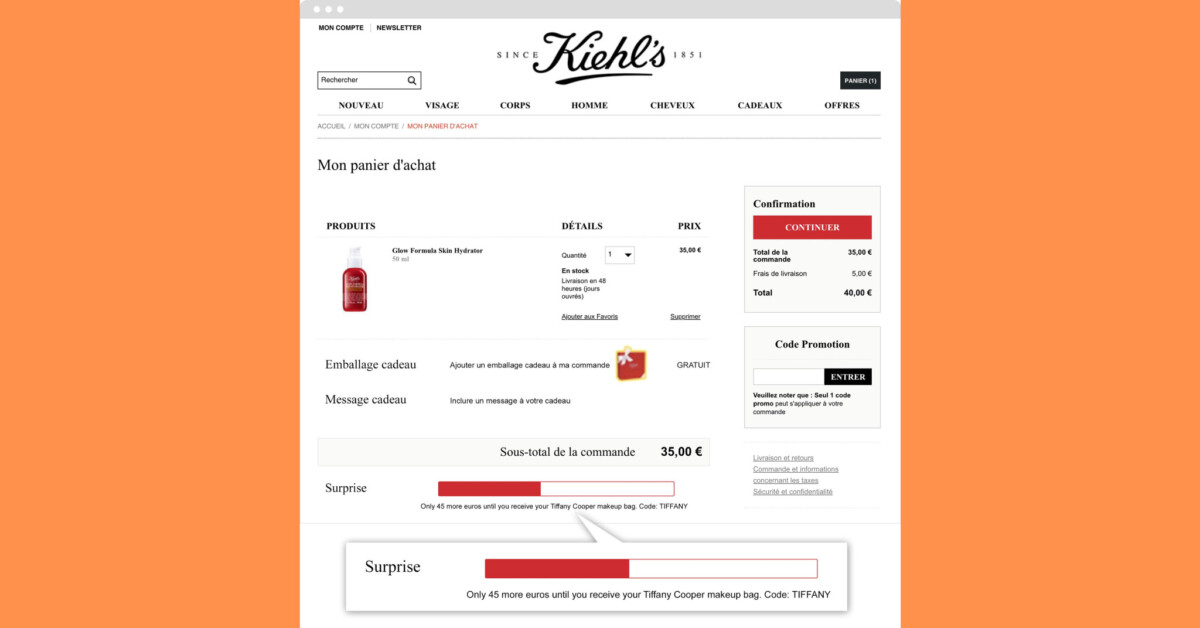
Key strategies:
- Add a progress bar of how much more the shoppers need to spend to unlock the gift, and display it in both the mini-cart and the main cart
- Choose gifts that have high profit margins, or slow-moving stock, preferably with a value of 10-15% of your average order value (AOV).
- Create urgency (48-72 hour time limit or seasonal gifts such as mini-size holiday gifts, summer tote bags).
- Announce the offer in various touchpoints: homepage banner, product pages, cart, and follow-up email for customers who are close to achieving the goal
KPIs: AOV (Average Order Value), threshold completion rate, and conversion of sessions with progress bar.
2) Tiered Gifts (Spend-More-Get-More)
Tiered gifting encourages the shopper to spend more through unlocking better gifts at each level, for example: Spend $50 → Gift A, $100 → Gift A + B, $150 → Gift A + B + C.
This model is best for beauty, fashion, lifestyle, and gift brands that have multiple small SKUs that can be aggregated into different tiers.
Below is an obvious example of a tiered gift system featuring three spending levels (a small gift for any order, free shipping for EUR40, and premium gifts unlocked at EUR70).
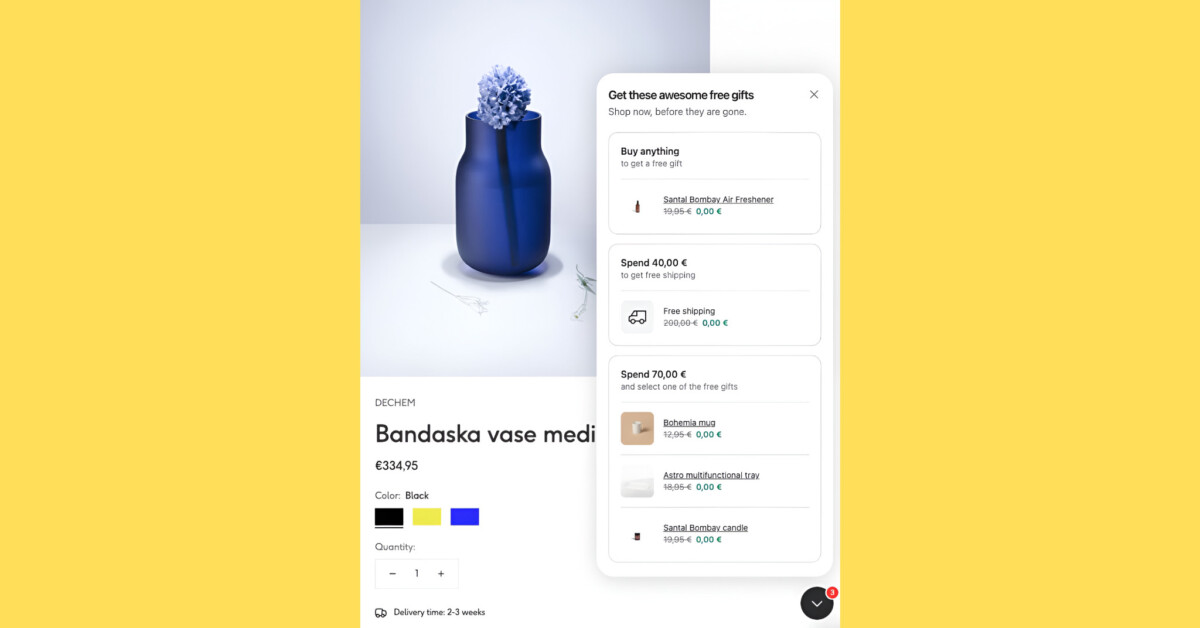
Key strategies:
- Use three clear tiers, with the top one featuring a visible hero gift in the cart.
- Add a progress bar that shows how close shoppers are to the next tier and set a short time limit for urgency.
- Bundle gifts by theme or value (e.g., Starter → Advanced → Pro) and keep total gift cost within 12–15% of the target AOV.
KPIs: AOV uplift by tier, tier-progression rate, and checkout conversion rate.
3) Free Samples with Purchase
Providing free samples is one of the easiest and most impactful ways of increasing trial and trust. It is most applicable for beauty, personal care, food & beverage, and home care brands, especially when launching new products.
As you see, the jewelry brand named Gemist allows customers to order a Free Try-On Box to try on three ring models from the comfort of their own homes before purchasing. Customer sampling reduces hesitation, instills confidence, and boosts conversion once they discover an outfit that makes them swoon.

Key strategies:
- Pair samples with the main routine (e.g., buy a serum → get a matching moisturizer).
- Limit to 1–2 samples per order and prioritize new arrivals that need exposure.
- Collect feedback via a post-sample survey or review email, then send a discount code for full-size purchases within 7–14 days.
KPIs: Sample-to-purchase rate, post-sample review rate, 90-day LTV of sample group.
4) Mystery Gift / Mystery Box
Mystery gifts or boxes spark curiosity and excitement by keeping the reward hidden: customers know the value, but not the exact item. This idea fits beauty, pop culture, accessories, and collectible brands especially well.
A good example is the Fall Mystery Box by ColourPop. For $49, shoppers get nine full-size products equaling more than $90. The element of mystery helps increase perceived value and surprise, which makes it even more of a self-purchase treat and fun gift option.
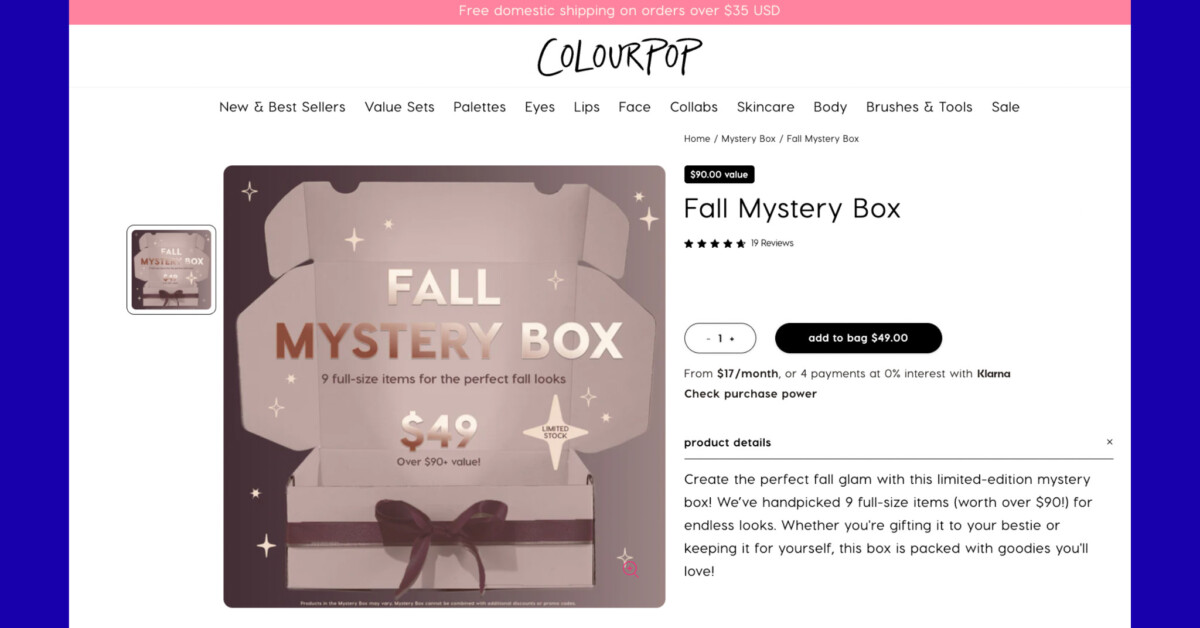
Key strategies:
- Clearly state the minimum guaranteed value (e.g., “Worth $90+”).
- Mix overstock items and best-sellers to balance excitement and cost.
- Add influencer or UGC unboxing videos to build hype and trust.
- Launch in seasonal batches (Halloween, Fall, Black Friday) to drive urgency.
KPIs: Take rate, AOV per mystery order, 60-day repeat-purchase rate.
5) Post-Purchase “Earned” Gift
Instead of giving a gift right away, this strategy rewards customers after they complete a purchase, for example, “Buy now, earn a free mini or bundle on your next order.” It’s ideal for repeat-purchase brands like coffee, skincare, or any subscription-adjacent business.
Domino’s “Emergency Pizza” campaign gives customers a free pizza after completing an eligible online order as part of its new Rewards program. It’s a post-purchase earned-gift strategy: buyers earn the right to claim a free pizza later, turning one transaction into an incentive for repeat visits and stronger loyalty.

Key strategies:
- Make the reward earned obvious on the thank you page, and send a reminder email/SMS within 7-10 days.
- Offer a limited time period (14-21 days) for repurchases to be made.
- Personalize the next gift according to the last purchase (e.g., buy a coffee machine – next order, get a capsule box).
KPIs: Repeat-purchase-rate (30/60 days), Reward redemption rate, Time to second order.
6) Digital/Access Gifts (early access, content, NFT, membership perk)
Digital gifts do not have to be tangible. They can be limited-access, content packages, or collectibles that further enable brand engagement. This strategy is appropriate for beauty, lifestyle, education, and tech brands that desire to create a stronger community of premium experiences.
With Starbucks Odyssey, the loyalty program of the company is introduced into a new virtual reality known as Web3, where people can own and earn digital points. Users take fun challenges such as quizzes or games, and NFT “Stamps” are awarded on Polygon, a low-cost and quick blockchain.
These stamps serve as digital collectibles unlocking real rewards in the form of exclusive access, workshops, or priorities in product access. It is a contemporary approach by which Starbucks will integrate online interactions with physical loyalty programs.
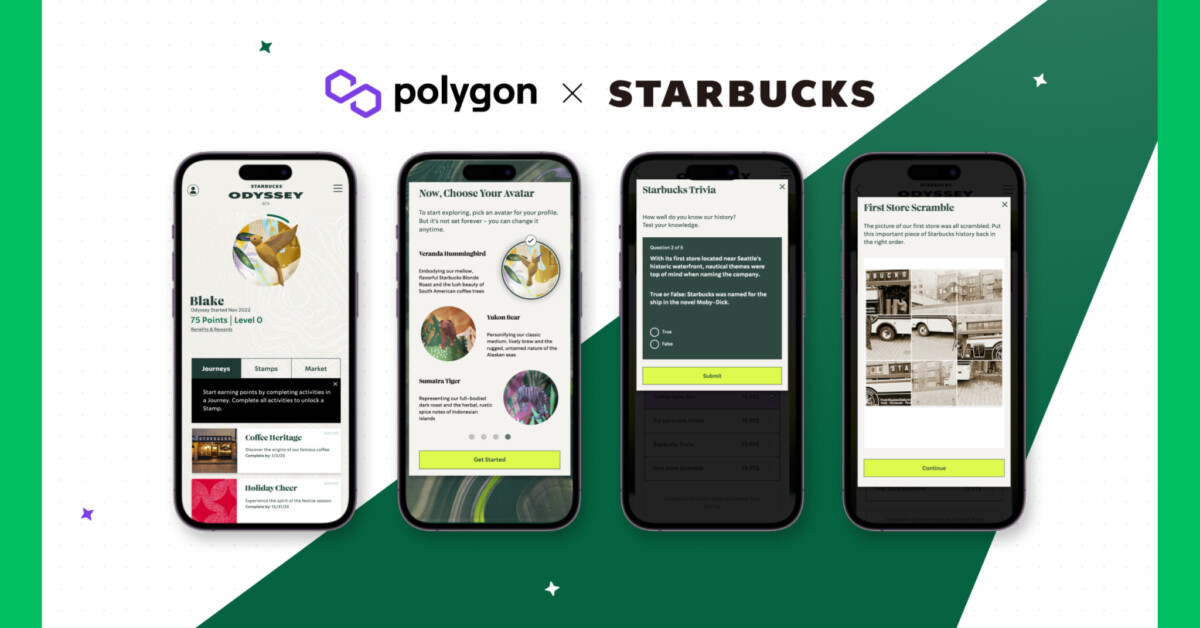
Key strategies:
- Offer members-only gifts such as early releases of products, limited virtual badges, or special vouchers.
- Provide valuable goodies (tutorials, presets, e-books) as a digital offer for more valuable purchases
- Special drops that include waiting lists or raffles to create buzz, user-generated content, and email sign-ups.
KPIs: Member sign-ups, engagement rate with digital perks, repeat-purchase rate.
7) Seasonal / Limited-Time Gift
Seasonal or limited-time gifts create urgency and excitement tied to specific moments, like holidays, school seasons, or cultural events. This type works for almost any retail brand, especially in beauty, fashion, and gifting.
KFC’s “Mother’s Day Buckquet” campaign turned a simple meal purchase into a limited-edition experience. Customers who ordered a Sides Lovers Meal during May 1–3 received a promo code for a Buckquet — a flower bouquet made of fried chicken and roses — available only for Mother’s Day. The quirky, time-bound offer drove buzz and short-term sales spikes.
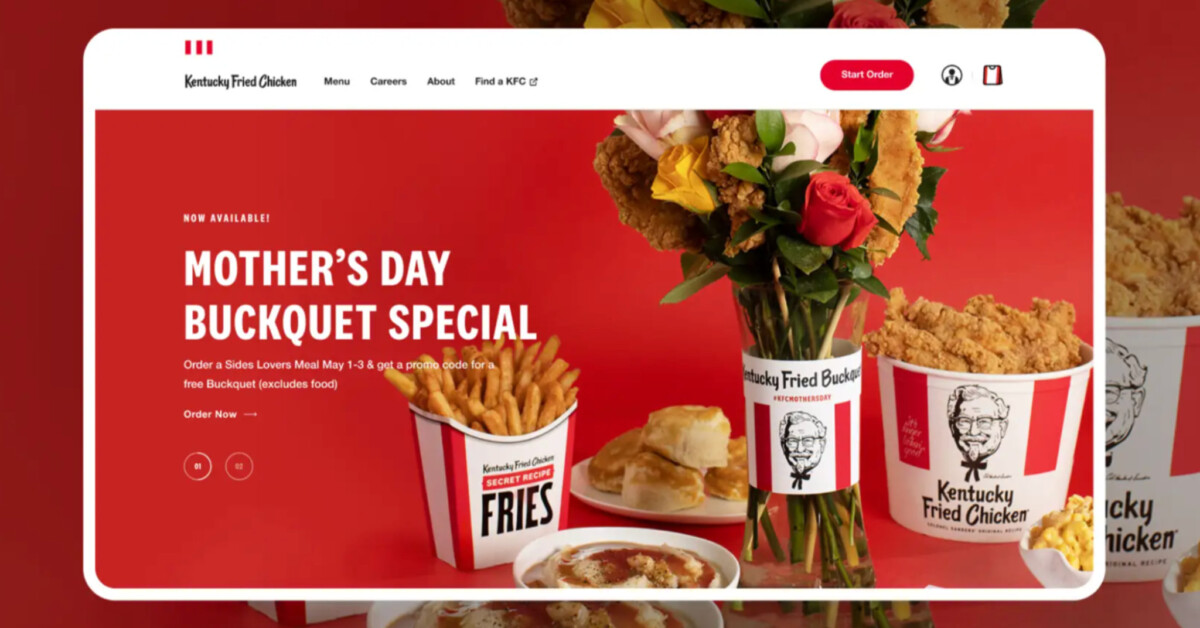
Key strategies:
- Design seasonal-themed gift sets (e.g., Holiday Mini Kit, New Year Lucky Bag).
- Use countdowns and limited quantities to highlight urgency and exclusivity.
- Run remarketing ads for carts that nearly reached the gift threshold, suggesting small add-ons to qualify.
KPIs: Campaign conversion rate, AOV vs. baseline, gift attach rate.
8) Subscription Milestone Gift
Milestone gifts reward customers for staying subscribed over time, for example, a free travel-size product on the 3rd renewal or a premium bundle on the 6th. It’s especially effective for consumable goods like coffee, vitamins, skincare, or pet care, where repeat purchases are natural.
NutriPaw uses Loop Subscriptions to automatically reward loyal buyers with free treats after several renewal cycles. Shoppers can pick their delivery frequency and enjoy built-in savings, turning routine reorders into small celebrations.
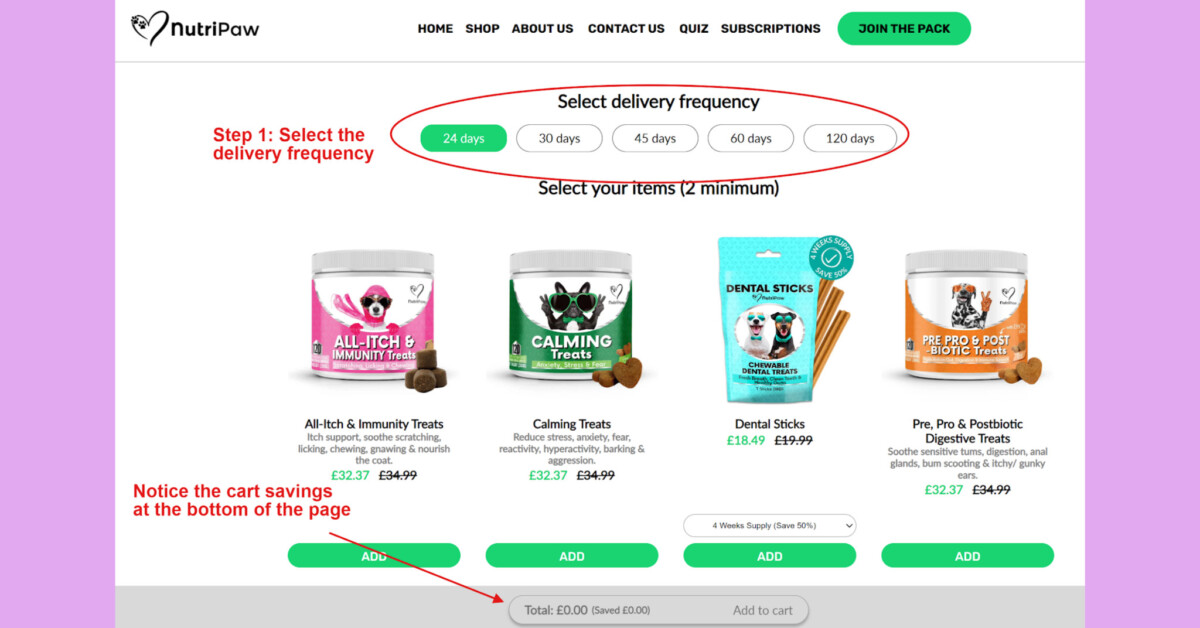
Good Protein also follows a similar model, offering 40% off the first order, 20% off recurring orders, and milestone gifts along the way, demonstrating that strategically-timed gifts make a subscription feel like a loyalty program.
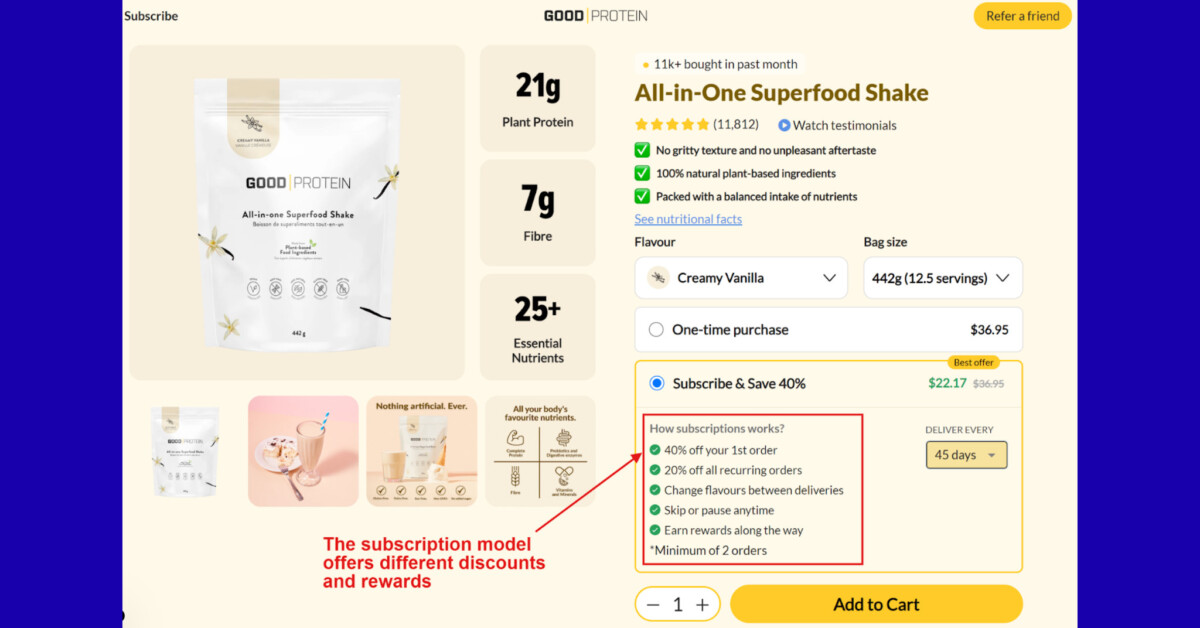
Key strategies:
- Reward tiers should be clearly defined (e.g., 2nd cycle → sample; 4th → full-size; 8th → premium gift).
- Let customers have a choice of gifts to avoid mismatches, and customer satisfaction is high.
- Inclusion of pre-renewal alerts that tell them how close they are to their next gift anniversary.
KPIs: Renewal rate, churn per cycle, AOV on milestone cycles.
Top 3 Free Gift Apps for Shopify (Expert Comparison & Insights)
1) BOGOS – Free Gift, BOGO, Bundles & Upsells

- Rating: 4.9/5 (2,470+ reviews)
- Price: Free plan available; paid tiers from $29.99–$99.99/month
The most extensively built and battle-proven free gift app on Shopify is BOGOS (formerly Free Gifts by Secomapp), which has a decade of trust in thousands of merchants all over the world. It contains all the scenarios (BOGO deals, spending quota rewards, mix and match deals, after-purchase offers). All that is handled in a streamlined, code-free dashboard.
Unlike other apps, BOGOS is more of an operating engine of marketing as opposed to a one-purpose item with advanced analytics, AI-assisted setup, and full integration with Shopify Checkout, Flow, and POS.
Key features:
- Auto-add or “choose your gift” popups
- Tiered progress bars
- Bundle & Build-a-Box builder
- Checkout & thank-you page upsells
- Multi-language support
- Real-time analytics
Pros: All-in-one promotion suite; rich customization; reliable at high order volume; responsive support.
Cons: Slight learning curve due to its depth; free plan caps monthly gift orders.
2) Rapi Bundles – BOGO, Quantity Breaks, and Free Gifts

- Rating: 4.9/5 (550+ reviews)
- Price: Free to install, paid plans from $15/month
Rapi Bundles is a bundle-oriented and lighter approach than BOGOS. It targets merchants with a more simplified focus, and customers can build mix-and-match bundles, quantity breaks, and BOGOs with very little configuration.
Although it doesn’t have the advanced analytics or upsell options that BOGOS offers, Rapi is easy to use and install and has built-in A/B testing, which makes it a viable option to consider to implement in small or mid-sized stores and increase AOV without having to deal with complicated campaign logic.
Key features:
- Mix-and-match bundles
- Volume and tiered discounts
- Auto-applied BOGO/free gifts
- A/B testing
- Multi-language & visual styling tools
Pros: User-friendly, affordable, fast to launch; supports bundle testing; no coding required.
Cons: Less automation depth; lacks advanced gift and checkout widgets found in BOGOS.
3) Monk – Free Gift + BOGO + Cart Upsell
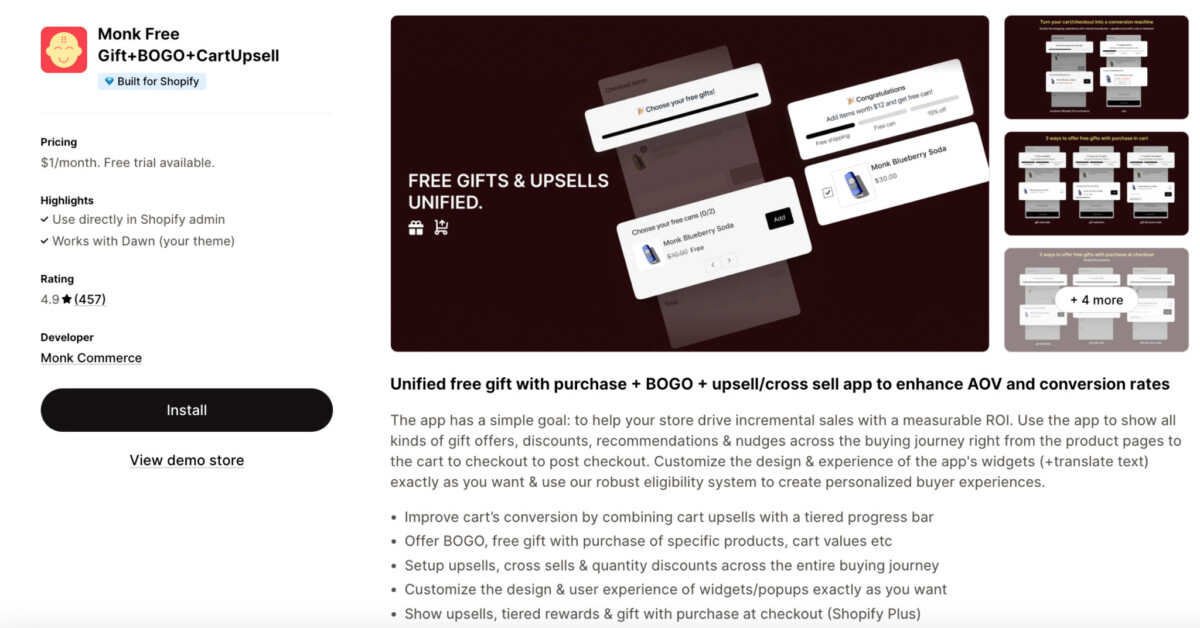
- Rating: 4.9/5 (450+ reviews)
- Price: Intro offer $1 for the first month, then standard pricing (7-day trial)
Monk specializes in checkout experience and engagement in carts with clean widgets for free gifts, tiered progress bars, and one-click upsells. It’s lighter than BOGOS but more visually polished than Rapi, making it ideal for conversion-focused merchants.
In short, if Rapi simplifies setup and BOGOS expands control, Monk perfects the middle ground, combining ease of use with strong visual impact right at checkout.
Key features:
- Cart-based gift rules
- Tiered progress bar
- Cross-sell and upsell widgets
- Customizable designs
- Multi-currency compatibility
Pros: Polished cart UX; easy to configure; strong visual customization; affordable entry price.
Cons: Limited depth in gift automation compared with BOGOS; no built-in A/B testing like Rapi.
Final verdict:
- BOGOS → best all-in-one solution for scaling brands running complex or seasonal gift campaigns.
- Rapi → best for smaller stores focused on bundles or simple free-gift triggers.
- Monk → best for brands that want smooth cart visuals and fast setup with low learning effort.
Final Thought
So, what’s the real takeaway here?
Strategic gifting is one of the most effective ways to build an emotional connection with your customers, which is the bedrock of true loyalty. The good news is you don’t have to figure it all out alone, as the right app can handle the heavy lifting for you.
With Shopify apps built for gifting, such as BOGOS or others in the same space, you can bring that experience to life effortlessly!
Good luck!
Frequently Asked Questions
What types of free gifts work best on Shopify?
Gifts that complement what the customer is already buying (e.g., a skincare serum sample when they buy a cleanser) tend to drive higher conversion. Also, tiered gifts based on spend and post-purchase rewards (gifts for next order) perform well. Studies in behavioral psychology show that “zero price” has a strong pull (people value free items more emotionally than equivalent discounts).
What are the best Shopify apps for creating free gift offers?
Apps like BOGOS, Rapi Bundles, and Monk are highly rated and used by many merchants for flexible gifting, bundles, and upsells. Among them, BOGOS is often praised as a “benchmark” free gift app in Shopify communities.
Can I offer digital gifts (like access or downloads) through a Shopify app?
Yes. Apps like Sky Pilot deliver e-books, videos, or PDFs instantly and securely after checkout. In addition, BIG Digital Downloads Products lets you send any file type (PDF, MP4, ZIP) in one click, perfect for digital freebies or rewards.
How can I measure if my free gift campaign is successful on Shopify?
Track metrics like conversion rate (how many redeem and purchase), repeat purchase rate (how many come back), and average order value. Also, monitor ROI and whether the free gift induced incremental sales rather than just being claimed by bargain seekers.
Are free gifts better than discount codes for loyalty on Shopify?
Often yes. Research shows that people prefer receiving something “extra” to having the base price lowered. Free gifts generate more emotional value and stronger recall than straightforward discounts.




